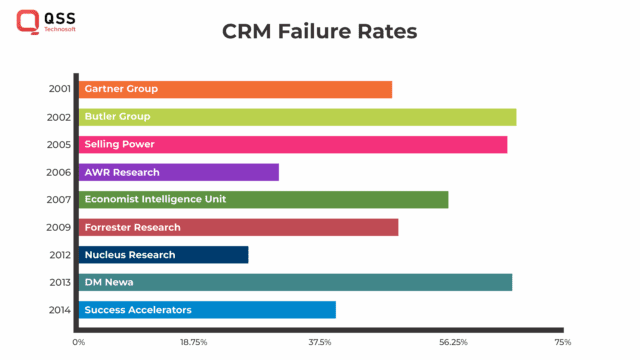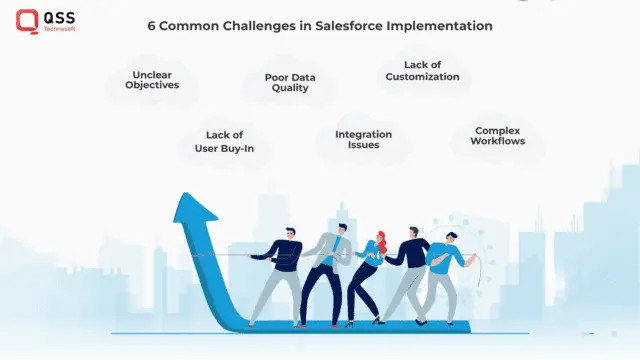Are you struggling to use the full potential of Salesforce to manage customer relationships, streamline sales processes, and drive marketing initiatives? You’re not alone. Many organizations face numerous challenges during the salesforce implementation phase, which can hinder their ability to unlock the true power of this powerful platform. In fact, studies show that 77% of CRM adoption projects fail to meet their objectives (Source: Harvard Business Review).
For example, imagine a scenario where a large retail company decides to implement Salesforce to enhance their customer service operations and boost sales. However, during the implementation process, they encounter difficulties in integrating Salesforce with their existing customer data systems, resulting in fragmented and incomplete customer records.
As a result, customer service representatives struggle to access accurate and up-to-date information, leading to a decrease in customer satisfaction and potentially lost sales opportunities.
Take a look at the comprehensive graph on CRM Failure rates as recorded by various research companies since 2001:

According to a study conducted by CIO Magazine, 55% of organizations struggle with user adoption, 38% face data quality issues, and 34% encounter difficulties with integration.
In light of these challenges, it becomes crucial to address and overcome them effectively to ensure a successful Salesforce implementation. So, how can you overcome these hurdles and make the most of Salesforce implementation? Let’s read more about practical solutions and recommendations that can help navigate the complexities involved, ensuring a smooth and impactful implementation process.
In this blog, we’ll explore some of the most common challenges in Salesforce implementation and provide practical strategies for overcoming them.
Read Our Old Blog: How CRM Integration to Logistics is Benefiting Logistics App Development
Understanding Salesforce Implementation & Challenge
Salesforce implementation refers to the process of setting up and configuring the Salesforce platform to meet the specific needs and objectives of an organization. It involves various tasks such as data migration, customization, integration with other systems, user training, and ongoing support.
During the implementation process, organizations often encounter common challenges that can pose barriers to a successful deployment
One life example of a Salesforce implementation challenge can be seen with a healthcare organization that adopted Salesforce as their customer relationship management (CRM) system. When migrating their data into Salesforce, they discovered inconsistencies and duplicates, due to the fact that they had been using multiple systems to track patient information.
The implementation team had to invest significant time and resources in cleaning up the data and ensuring that all records were accurate and up-to-date before importing them into Salesforce.
In order to overcome this challenge, the implementation team provided extensive support and emphasized the benefits of using Salesforce, such as being able to easily access patient data from any location. Through these efforts, the healthcare organization was able to successfully implement Salesforce as their CRM system, improving their patient data management and overall efficiency.
Read Our Old Blog : Enhancing Reports and Dashboards in Salesforce Apps
6 Main and Common Challenges in Salesforce Implementation
Let’s take a look at 6 most common and main challenges in salesforce implementation. By understanding these challenges you will be able to figure out roadblocks and take the measurable step ahead.

Challenge 1: Unclear Objectives
One common challenge during Salesforce implementation is having unclear objectives. It is crucial to define clear goals and objectives for the implementation process. This includes identifying the specific business processes that Salesforce will improve, determining the desired outcomes, and establishing key performance indicators (KPIs) to measure success. Without clear objectives, it becomes difficult to align the implementation efforts and prioritize customization and configuration tasks.
To overcome this challenge, follow these steps:
- Identify key stakeholders and decision-makers in your organization.
- Clearly define your goals and objectives for implementing Salesforce, including specific metrics you hope to achieve.
- Prioritize your objectives and align them with your overall business strategy.
- Create a detailed implementation plan that outlines timelines, budgets, and key milestones.
- Set up regular check-ins with your team to review progress and adjust your plan as needed.
Challenge 2: Lack of User Buy-In
User adoption is crucial for a successful Salesforce implementation. If users do not see the benefits or are resistant to change, it can hinder the adoption and utilization of the platform. Lack of user buy-in can lead to underutilization, lower productivity, and a failure to achieve the expected return on investment (ROI). Even the best CRM system won’t deliver results if your team members don’t use it.
To encourage buy-in from your users, consider the following:
- Involve your team members in the implementation process. Solicit feedback on their workflows, pain points, and feature preferences.
- Provide training and support to ensure all users know how to use the platform effectively.
- Highlight the benefits of using Salesforce, such as increased productivity, improved accuracy, and better collaboration.
- Lead by example. Encourage adoption from your team by consistently using Salesforce yourself.
Challenge 3: Poor Data Quality
Maintaining accurate and high-quality data is essential for the effective use of Salesforce. Poor data quality can lead to inaccurate reporting, ineffective decision-making, and a loss of trust in the system. Data inconsistency, duplicates, and incomplete records can undermine the system’s effectiveness.
To address this challenge:
- Establish clear data entry protocols and guidelines.
- Regularly audit your data to identify potential errors or inconsistencies.
- Use data cleansing tools to identify and clean up duplicate or inaccurate records.
- Encourage users to actively manage and update their data on an ongoing basis.
Challenge 4: Integration Issues
Salesforce implementation often requires integrating with other systems like ERP, Marketing Automation, or Customer Support systems. Integration challenges can arise due to differences in data structures, compatibility issues, or complexity in establishing connections.
To streamline the integration process, consider the following:
- Clearly define your requirements, and identify any potential issues or challenges in advance.
- Work with a qualified Salesforce partner or consultant to ensure a smooth integration process.
- Create a detailed integration plan that outlines timelines, budgets, and key milestones.
- Test your integration thoroughly to ensure all systems are working as expected.
Challenge 5: Lack of Customization
Salesforce offers a wide range of standard functionalities, but organizations often require customizations to align with their unique business processes. If there is a lack of customization, it can result in a disconnect between the system and the organization’s specific requirements, leading to inefficiencies and limited user adoption. While Salesforce offers many powerful out-of-the-box features, every organization is unique, and customization is often necessary to fully optimize the platform.
To address this challenge:
- Work with a qualified partner or consultant to identify areas where customization may be necessary.
- Clearly define your customization needs and prioritize them based on their impact on your business objectives.
- Regularly review and adjust your customization as needed to ensure it’s aligned with your goals.
Challenge 6: Complex Workflows
Salesforce allows organizations to define and automate complex workflows to streamline business processes. However, designing and implementing complex workflows can be challenging and time-consuming, especially when there are multiple stakeholders and different approval processes involved. This is a complex platform with many features and capabilities. As a result, workflows can quickly become overwhelming, confusing, or inefficient.
To simplify your workflows:
- Regularly review and optimize your workflows to remove any unnecessary steps or tasks.
- Automate repetitive tasks and processes using process builder or flow.
- Use validation rules and triggers to ensure data integrity and accuracy.
- Use Salesforce’s reporting and analytics features to identify areas for improvement.
Read Our Old Blog : Debugging and Troubleshooting in Salesforce
Best Way To Overcome Common Challenges in Salesforce Implementation
We, at QSS Technosoft, differentiate ourselves by offering unique and comprehensive solutions to overcome challenges in Salesforce implementation.
Here are some additional points on how we can help:
1. Expert consultation and strategic planning: Our team of Salesforce experts will work closely with your organization to understand your goals and challenges. We provide expert advice and strategic planning to ensure the successful implementation of Salesforce aligned with your business objectives.
2. Agile implementation methodology: We follow an agile approach to Salesforce implementation, breaking the project into manageable phases and delivering incremental value. This allows for flexibility, and quick feedback cycles, and ensures that your organization can adapt and evolve as needed throughout the implementation process.
3. Data quality assurance: We understand the importance of data integrity and take extra measures to ensure a smooth data migration process. Our team follows best practices to clean, validate, and transform data, ensuring accurate and reliable data migration to Salesforce.
4. Integration expertise: We specialize in integrating Salesforce with various third-party systems, such as ERP, marketing automation, and customer support platforms. Our integration solutions ensure seamless data flow and process automation across systems, enabling a unified view of customer data and efficient workflows.
5. Continuous improvement and innovation: Our commitment to your success doesn’t end with implementation. We provide ongoing support and maintenance services to address any issues and continuously improve your Salesforce implementation based on changing business needs. We stay up-to-date with the latest Salesforce updates and innovations, leveraging them to enhance your Salesforce instance.
By choosing QSS Technosoft for your Salesforce implementation, you will have a dedicated partner who understands your unique challenges and is committed to delivering customized solutions that meet your business requirements while driving maximum ROI and user adoption.
Conclusion
Salesforce implementation can indeed be a complex process, but with the right approach and a trusted partner like QSS Technosoft, you can navigate the challenges with ease. While it may seem daunting, it is important to note that Salesforce offers numerous benefits for organizations of all sizes. By working closely with QSS Technosoft, you can ensure a successful implementation that aligns with your unique business objectives.
Don’t let the complexity of Salesforce intimidate you. With QSS Technosoft’s expertise and guidance, you can confidently overcome any obstacles and streamline your business processes. So, what are you waiting for? Take advantage of Salesforce implementation and take the full potential of your organization today. Contact QSS Technosoft to get started on your Salesforce journey!
We are proud to mention that our work has been recognized by leading B2B reviews and research platforms like GoodFirms, Clutch, MirrorView, and many more.


Overcoming Common Challenges in Salesforce Implementation: A Practical Guide